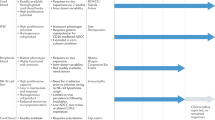Abstract
CYTOLYSIS of antibody-coated tumour cells mediated by reticuloendothelial (RE) or bone marrow cells is a phenomenon of unknown biological relevance1–4. The specificity of the reaction lies in the antibody5,6; probably most or all cells able to recognise the Fc fragment of the antibody molecule can mediate this reaction, including lymphocytes and monocytes6,7, circulating cultured transformed lymphoblasts8, polymorphonuclear leukocytes9 and malignant reticulum cells10. In tumour systems the contribution of this reaction is difficult to distinguish in vivo from other cytolytic phenomena, including complement-dependent antibody-mediated cytotoxicity, T-cell cytotoxicity or cell killing exerted by “armed” macrophages11,12, all of which may be active in various degrees in different experimental circumstances. But antibody-dependent cellular cytotoxicity (ADCC), as this phenomenon has been termed13, seems to be of potential therapeutic interest because both its magnitude and specificity depend on specific antibody levels, and antibody levels may be potentially more manipulable in man than are the cellular elements of a host anti-tumour response. In addition, there is preliminary evidence that fixed tissue macrophages may be active in eliminating circulating metastatic cells by this mechanism14. It was therefore interesting to determine whether functional ADCC could be demonstrated in vivo independent of other cytolytic mechanisms since its demonstration has so far been limited to in vitro assays.
This is a preview of subscription content, access via your institution
Access options
Subscribe to this journal
Receive 51 print issues and online access
$199.00 per year
only $3.90 per issue
Buy this article
- Purchase on Springer Link
- Instant access to full article PDF
Prices may be subject to local taxes which are calculated during checkout
Similar content being viewed by others
References
Möller, E., Sience, 147, 873–879 (1965).
Perlmann, P., and Holm, G., Adv. Immun., 11, 117–193 (1969).
MacLennan, I. C. M., Transplant Rev., 13, 67–90 (1972).
Perlmann, P., Perlmann, H., and Wigzell, H., Transplant. Rev., 13, 91–114 (1972).
Pollack, S., Heppner, G., Brawn, R. J., and Nelson, K., Int. J. Cancer, 9, 316–323 (1972).
Möller, G., and Svehag, S.-E., Cell Immun., 4, 1–19 (1972).
Perlmann, P., and Perlmann, H., Cell. Immun., 1, 300–315 (1970).
Lefebre, J.-G., Petitprez, A., Juy, D., and Bona, C., Eur. J. Immun., 5, 266–270 (1975).
Gale, R. P., and Zighelboim, J., J. Immun., 114, 1047–1051 (1975).
Ralph, P., Prichard, J., and Cohn, M., J. Immun., 114, 898–905 (1975).
Evans, R., and Alexander, P., Nature, 236, 168–170 (1972).
Greenberg, A. H., and Shen, L., Nature, 245, 282–285 (1973).
Van Boxel, J. A., Stabo, J. P., and Paul, W. E., Science, 175, 194–195 (1972).
Draz, S., Byfield, J. E., Byfield, P. E., and Fonkalsrud, E. W., Arch. Surg., 102, 574–577 (1971).
Augusti-Tocco, G., and Sato, G., Proc. natn. Acad. Sci. U.S.A., 66, 311–315 (1970).
Schubert, D., Humphreys, S., Baroni, C., and Cohn, M., Proc. natn. Acad. Sci. U.S.A., 66, 316–323 (1970).
Klebe, R. J., and Ruddle, F. H., J. Cell Biol., 43, 69a (1969).
Finklestein, J. Z., Arima, E., Byfield, P. E., Byfield, J. E., and Fonkalsrud, E. W., Cancer Chemother. Reps., 57, 405–412 (1973).
Arima, E., Byfield, J. E., Finklestein, J. Z., and Fonkalsrud, E. W., J. pediat. Surg., 8, 757–763 (1973).
Gerson, J. M., and Koop, C. E., Sem. Oncol., 1, 35–46 (1974).
Akeson, R., and Herschman, H. R., Proc. natn. Acad. Sci. U.S.A., 71, 187–191 (1974).
Akeson, R., and Herschman, H. R., Nature, 249, 620–623 (1974).
Hellström, K. E., and Hellström, I., A. Rev. Med., 23, 19–38, 1972.
Byfield, J. E., and Karlsson, U., Cell Diff., 2, 55–64 (1973).
Wigzell, H., Transplantation, 3, 423–431 (1965).
Byfield, J. E., J. supramolec. Struct. (in the press).
Van Loveren, H., and Den Otter, W., J. natn. Cancer Inst. 52, 1917–1918 (1974).
Perlmann, P., Perlmann, H., and Biberfield, P., J. Immun., 108, 558–561 (1972).
Author information
Authors and Affiliations
Rights and permissions
About this article
Cite this article
BYFIELD, J., ZERUBAVEL, R. & FONKALSRUD, E. Murine neuroblastoma cured in vivo by an antibody-dependent cellular cytotoxicity reaction. Nature 264, 783–785 (1976). https://doi.org/10.1038/264783a0
Received:
Accepted:
Issue Date:
DOI: https://doi.org/10.1038/264783a0
Comments
By submitting a comment you agree to abide by our Terms and Community Guidelines. If you find something abusive or that does not comply with our terms or guidelines please flag it as inappropriate.



